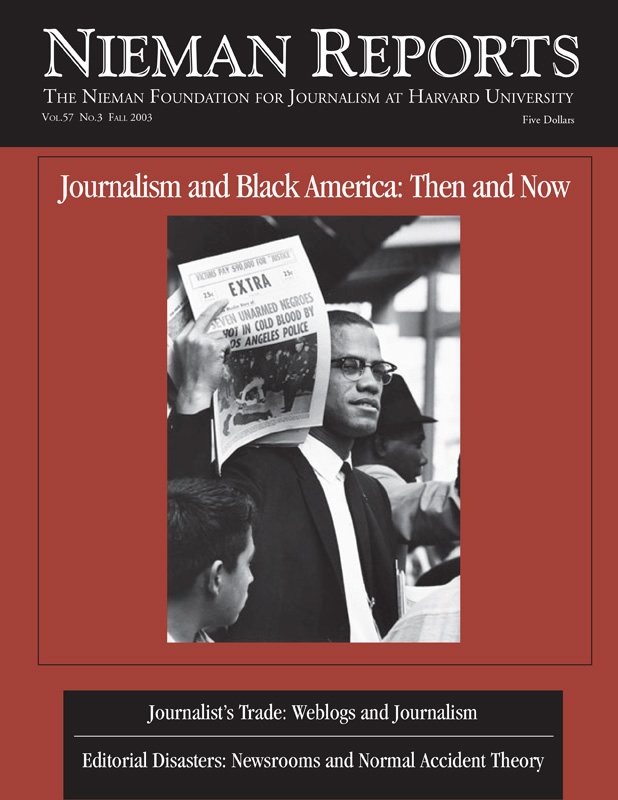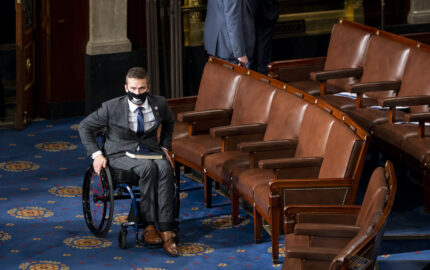African-American newspaper publishers got a new and unlikely colleague in 1998—boxing promoter Don King. That’s right, the controversial sports impresario with the trademark Afro, outbidding all comers, paid $760,000 for the Cleveland Call & Post, rescuing from bankruptcy an illustrious black weekly dating to 1902.
“The Lord is directing my path,” he told a convention of the National Newspaper Publishers Association (NNPA), trade group of America’s black press. And he promised in a Call & Post editorial to “continue the legacy of founder Williams O. Walker. The light will continue to shine.”
Skeptics might see an embattled public figure burnishing his image after making millions in the fight game. But almost immediately the native Clevelander bought new equipment for the paper, replaced its phone system, and has used his deep pockets and high-powered contacts to increase advertising and circulation.
Naturally, Cleveland readers and the 200-some publishers in the NNPA welcomed King with open arms. But it wasn’t the only time that the financially strapped black press needed a knight to rescue a failing but important institution.
Take The Chicago Defender. Founded in 1905 and one of the greatest newspapers ever published, the Defender jump-started the Great Migration in the early 1900’s, when millions heeded its call to leave the Klan terror and pseudo-slavery of the South behind for freedom and opportunity up North. In 1928 it helped elect Oscar DePriest the first black congressman after Reconstruction, pushed President Harry Truman to integrate the U.S. military in the 1940’s, and pioneered demands for racial equality that sparked the civil rights movement. It went daily in 1956 and acquired a regional chain circulating 522,000 papers. But its future was thrown into limbo in 1997 with the death of publisher John H.H. Sengstacke. Then, in late 2002, after five years of legal and financial wrangling, it was bought for $10 million by Real Times, Inc., a Chicago-based multimedia company headed by Thomas Picou, a Sengstacke family member.
“Chicago Daily Defender remains in Black hands,” said a relieved black journalism review on its Web site, www.blackjournalism.com.
The Link to Ethnic Progress
Once considered an outdated protest medium, the black press today is appreciated as crucial to ethnic progress. And a host of individuals and advocacy groups are coalescing to support it. The Defender deal, for instance, also reversed the uncertain fortunes of the 67-year-old Michigan Chronicle by attracting Detroit-based investors, including District Judge Greg Mathis, funeral director O’Neil Swanson, Detroit Black Chamber of Commerce chair Vivian Carpenter, and others.
Earlier this year, National Association for the Advancement of Colored People board chairman Julian Bond, the National Black Anti-Defamation League, and other groups, protested a Black History Month advertising campaign by Nissan that excluded black papers. The National Black Family Empowerment Agenda, a clearinghouse for ideas on racial progress that sponsors initiatives like “Renounce and Denounce the N-Word Resolution” and publishes its own paper, The Challenger, has a “buy black” program benefiting media. Visitors to its Web site can complete a resolution form pledging to “subscribe to at least one black newspaper, and call upon public and private entities to guarantee an equitable share of advertising revenue.”
And when Black Entertainment Television (BET) was sold to Viacom in 2001, which subsequently canceled BET’s main public affairs shows—the newsmagazine “BET Tonight with Ed Gordon” and “Lead Story,” which featured heavy-hitting political pundits Clarence Page, Cheryl Martin, DeWayne Wickham, George Curry, and Armstrong Williams—the NNPA made it an object lesson on the perils of nonblack ownership. “Even with its videos, the old BET provided more black-oriented public affairs programs than all of the other cable networks combined,” wrote NNPA national correspondent Artelia C. Covington.
NNPA leaders have publicly criticized the recent FCC vote relaxing ownership restrictions as a threat to alternative voices like the black press, at a time when affirmative action and a range of social issues are under assault. And they’ve capitalized on public relations opportunities, like last year’s race-based boycott of the Philadelphia Daily News over insensitive crime coverage. Six black newspapers promoted it, touting their own journalism bona fides in a related advertising campaign with the tagline, “More than 1.2 million readers every week get the truth about the black community from the Black Press.” Participating papers included not only smaller publications like the 60,000-circulation Neighborhood Leader and Scoop, which distributes 105,000. There was also The Black Suburban Journal at 150,000, Philadelphia Sun and Philadelphia New Observer, both at 240,000, and the 420,000-circula-tion Philadelphia Tribune.
At the NNPA’s 63rd annual convention in June, there were some 400 publishers, editors, writers and photographers representing not only standard-bearers like the 70-year-old Los Angeles Sentinel, 98-year-old Chicago Defender, and 119-year-old Philadelphia Tribune, the nation’s oldest continuously published black newspaper. There were relative newcomers like the Ft. Lauderdale Westside Gazette, started in 1971, and the Villager, founded in 1973 in Austin, Texas.
There were old hands, like newly elected NNPA president Sonceria Mes-siah-Jiles, publisher of the Houston Defender, but also new blood like George Curry, the Chicago Tribune veteran, chosen National Association of Black Journalist’s “2003 Journalist of the Year.” Curry is editor in chief of BlackPressUSA.com, the official NNPA News Service Web site and an online network of 15 black-owned papers, including the New York Amsterdam News, The Jacksonville (Fla.) Advocate, The Toledo Journal, Philadelphia New Observer, and Milwaukee Courier.
Curry covered the war on Iraq for NNPA News Service and BlackPressUSA.com, noting in his online journal, “Eight Days in Doha, Qatar,” that outgoing NNPA president John J. “Jake” Oliver, Jr., a black press veteran and publisher of the Baltimore Afro-American, schooled him on the gravity of a black media presence at the scene. Curry wrote: “What Jake saw at the outset and I didn’t was that my presence in the daily briefings would do wonders for the NNPA. In his mind, my being there allowed us to play on the world stage and let the world know that there is a strong, vibrant black press in the United States. … Just as many African Americans, even those who oppose the war on Iraq, take pride in U.S. Army Brig. Gen. Vincent Brooks when he steps up to the briefing room’s podium every day, there would be a certain segment of black America that would also be proud to see a black journalist ask questions about Iraq.”
As a war correspondent, Curry continued a proud black press tradition. The Pittsburgh Courier, The Chicago Defender, and other papers provided critical insights on both world wars from regular dispatches by correspondents on the ground. In the 1960’s, Muhammad Speaks had bureaus in Africa and at the United Nations.
The Black Press’s History
The U.S. black press is 176 years old this year. It began in 1827 when John Russwurm and Samuel Cornish started Freedom’s Journal in New York. By the Civil War, 40 black newspapers were being published. And, during the 1920’s and 30’s, when major papers virtually ignored black America, the glory days of the black press began.
Back then, major papers usually wouldn’t even run African-American obituaries. Black papers became the primary means of group expression and main community service outlet, reporting on job opportunities and retailers that didn’t discriminate, and covering charity events in uplifting society pages with big pictures of smiling, dignified black people enjoying each other’s company. Politics, sports, money and social issues were reported from the perspective of black readers. The careers of Lena Horne, Little Richard, Paul Robeson, and many other entertainment greats were promoted in their early stages before major media took notice, and editorial writers crusaded for open housing, quality schools, voting rights, fair employment, and equal accommodations—demands that later formed the civil rights agenda. There were bylined stories from America’s leading black activists and intellects—Richard Wright, Gwendolyn Brooks, and Langston Hughes in The Chicago Defender and W.E.B. DuBois, Zora Neale Hurston, Marcus Garvey, and Elijah Muhammad in the Pittsburgh Courier.
Black publishers grew rich and powerful. Robert S. Abbott started the Defender with $13.75 and became one of America’s first black millionaires. By 1929, the Defender circulation was 230,000 a week, but the Pittsburgh Courier was biggest, topping 300,000 with 15 editions across the country. In 1932, Courier publisher Robert L. Vann, Abbott and others steered black voters en masse to the Democratic Party, breaking traditional ties to the Republican Party of Abraham Lincoln and helping to elect Franklin D. Roosevelt President. Gunnar Myrdal’s landmark 1944 study, “An American Dilemma: The Negro Problem and Modern Democracy,” said the strongest, most influential institution among blacks was its crusading press. It set the stage for—and helped engineer—monumental change from school desegregation in 1954 to the voting rights bill of 1957, the marches, sit-ins and civil rights legislation of 1964.
By the Black Power era, the formerly cutting-edge medium was considered powerless. The black press was considered, at best, a farm team for major dailies, which recruited top black journalists to cover the civil rights movement and eventually attracted readers and advertisers once considered the black press’s captive market. Conventional wisdom by the 1980’s was that the black press, by doing such a bang-up job promoting racial equality, had made itself obsolete.
The Black Press Today
In reality, racism remains a major obstacle to black progress in America today. Forty years after the March on Washington, Martin Luther King, Jr.’s dream is still unachieved—and the black press is still on the case. The NNPA, founded in 1940, has kept the professional house in order, promoting journalism excellence as an alternative media industry. Its NNPA News Service supplies government and foreign affairs coverage to member publications and distributes nationally the local stories they originate.
There is also the NNPA Foundation, a tax-exempt entity that awards scholarships, runs a student internship program, and bestows journalism prizes like the A. Phillip Randolph Messenger Award for Excellence. In partnership with Howard University, it also operates the Black Press Institute that conducts market research and career development seminars and archives black newspapers. Two years ago, the NNPA created BlackPressUSA.com. The Web site is a project of the Black Press Institute and handled by XIGroup, a Web development firm co-owned by Joy Bramble, publisher of The Baltimore Times, an NNPA member publication. The project has increased the number of black papers online by helping to create or update individual sites and linking them to BlackPressUSA.com.
The Web site features news and commentary exclusively by black journalists from black-owned publications, presenting itself as “a gateway” to America’s black press with a combined readership of 15 million. It is a specialty medium, and its stories are unlikely to appear in other major newspapers. What follows is a sampling of headlines:
Bush’s Tax Cuts Crippled the Poor
The Questions Sisters Ask About General Vincent Brooks
Harlem Guard Unit is Prepared for Iraq
Blacks Fear War With Iraq Would Drain Resources From Social Programs
Lawsuit Says DaimlerChrysler Treated Black Car Buyers Unfairly
Study: Blacks Live Closer to, Suffer More From Power Plants
In the wake of the Jayson Blair situation, George Curry’s article, “Colorizing The New York Times Plagiarism Case,” appeared on the Web site. It typifies the alternative perspective readers of the black press rely on. As Curry wrote, “When it was discovered that columnist Mike Barnicle of The Boston Globe and Stephen Glass of The New Republic had engaged in writing stories that contained more fiction than fact, no one indicted all white journalists for their misdeeds or blamed it on white privilege,” Curry wrote. “To be blunt, they were simply thieves. And so was Blair.”
Ever scrappy and rambunctious, the black press doesn’t hold much sacred. Even the highly regarded documentary, “The Black Press: Soldiers Without Swords” got the once-over for historical omissions and faulty research in a 2000 Journal of MultiMedia History essay by Reginald Owens, former managing editor of The Informer and Texas Freeman. In an otherwise complimentary review, Owens wrote that the 1998 film minimized the black press’s role in the Harlem Renaissance and Black Power movement; underplayed its importance in electoral politics; didn’t mention Ebony and Jet, the Johnson Publishing Co. magazines that first attracted national ads by developing a black middle-class audience, and generally misrepresented black newspapers by prematurely ending its fascinating saga in 1975.
“Yes, there are fewer readers,” Owens acknowledges. “Yes, black papers are no longer the main media for many African Americans. Yes, the number of black publications goes up and down depending on social and political circumstances. Nonetheless, the black press is no more dead than the white press. An analysis of the numbers—historical and current—simply does not support the idea.”
Owens quotes circulation numbers from Gales Directory of National Publications and Broadcast Media, showing long-term growth that disputes perceptions of a black press in decline. Totaling about 150 papers with three million readers in 1965, shortly before the “Soldiers Without Swords” timeline ends, the black press actually included 230 papers in 1998 when the documentary aired, according to Gales, which listed in its 2001 edition 237 publications with 15 million readers.
Strengthening the Black Press
But the black press has a ways to go before reaching its full potential.
Overall, coverage must be improved. The Philadelphia Tribune swept the awards competition at this year’s NNPA convention, taking the coveted Russwurm Award for “Best Newspaper in America” and placing first in five categories—Best News Pictures, Community Service, Best Business Section, Best Church Page, and Best Entertainment Section. More black newspapers must perform at this high level of quality journalism.
Black papers must seek advertising more aggressively. There are few ads on the BlackPressUSA.com Web site, and when King first took over the Call & Post, some Cleveland advertisers said the newspaper’s ad reps had been slow to approach them. But to win big accounts, black papers need to stop relying on protests and moral suasion and instead bring an appealing readership demographic to the table. This means black papers must attract younger readers. The average NNPA reader is 44 years old, 54 percent male and 60 percent college trained; it is not the free-spending 20-something reader that most advertisers want.
But most of all, black papers must continue the proud tradition of courageous journalism established at arguably its finest hour, during World War II. I wrote a play about it, “Double V: A Docudrama of the Negro Press and World War II,” which dramatically presents fearless black publishers putting out damn good papers despite newsprint shortages, unfair rationing, FBI harassment, and loss of advertisers. The “Double V” campaign—victory against Hitler abroad and victory against racism at home—not only set a standard for wartime news coverage but also helped integrate the U.S. military in 1948.
NNPA president Messiah-Jiles said in a press statement: “What the black press offers is a historical record, which is a base for knowledge and a catalyst for change. It can empower us to act, and also challenge the powers that be to move in a positive direction.”
Larry Muhammad is a reporter for The Courier-Journal in Louisville, Kentucky. His play, “Double V: A Docudrama of the Negro Press and World War II,” was published in 2002 by Harmony House and is available directly from the author.



